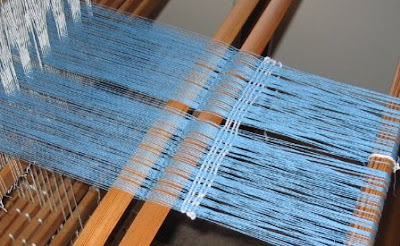Can you believe it? And still in time for the cold weather to wear it in!

This cardigan incorporates fleece samples from a total of 17 different rare breeds of sheep:
* The body of the sweater (both the white and the green) is Ryeland.
* The blue for the peeries and seeding pattern is Hog Island.
* The Sheep:
Front top row (from left):
North Ronaldsay, Teeswater, North Ronaldsay (to show a different color),
Leicester Longwool,
California Variegated Mutant, and Whiteface Woodland.
Front bottom row (from left):
Three Shetlands (in different colors) , and a family of four Navajo-Churros.

Back top row (from left): Tunis, Ryeland,
Karakul, Jacob, and Wensleydale.
Back bottom row front (from left): North Ronaldsay, Hebridean, Soay,
Manx Logthan, and Lincoln.
I have been working on this project for a very long time. The idea for it came during the
Online Guild's Hebridean Rare Breed Challenge, back in August of 2002. I only had a sample of Hebridean fleece, and being a project person by nature, didn't want to simply let the yarn sit in a box somewhere. I wanted to
do something with it. The idea of being able to show off my Heb yarn as a sheep motif in a sweater came from that.
So I started collecting small amounts of whatever rare breed fibers I could get my hands on. Some were raw fleece, some prepared rovings. Some I purchased, but many of them came as gifts from other fiber folk who simply wanted to encourage me along in this project. I got the fleece for the body of the sweater in February 2003, again from an Online Guild Rare Breed Challenge. This time the breed was Ryeland, and I was able to purchase a kilo of it. I admit that it isn't the softest choice for the body of any sweater, but the amount was enough, and I don't mind wearing turtlenecks with sweaters!
Finally in
October 2006, I had enough yarns to actually begin working on swatches and a design. I am neither an expert knitter nor a knitwear designer, but as with most things in my life, I pressed on in the confidence that I
can do this, and at the very least, learn a few things along the way.
Actually I have learned quite a bit, as I've had to deal with problems and challenges. Each of this took time to consider the possibilities and make a decision about them. I've had to deal with
mathematical challenges, such as trying to work out the sheep motif placement;
design challenges, such as choosing the seeding pattern and organizing the yarn colors; and
yarn problems, such as running out of green yarn!
Speaking of
that green yarn, I took your suggestions and alternated rows of the old green with the new for the button and neck bands. The new green, though an unbelievably close match, still looks "off" in certain lightings. I think if you look closely at the sweater now, you can tell there is a slight color difference between front and neck bands, and the bottom and sleeve ribbing. Hopefully not enough to be too terribly noticeable!(???) Even so, I'm much happier with a green neckband than the white one.

Another decision that required a lot of thought was the buttons. The ones I ended up using (pictured at left) are not
the ones I bought at SAFF, which, though lovely, just didn't suit the sweater. I did find some adorable pewter sheep buttons at
Morehouse Farm, but alas, they were all sold out.
With all that, plus the fact that I am a slow knitter who doesn't work on large projects during the hot summer months, this sweater has been quite the work in progress. There are some knitting flaws, but I'm not planning on pointing those out to anyone. Happily, the sweater is a perfect fit.
So, I've wrapped up an old project on the last day of the old year. Very exciting as I'm looking forward to starting some swatches with my
Shetland yarns. And with that I want to wish you and yours a very happy and safe New Year.
© 2008 Leigh's Fiber Journal
Related Posts:





































